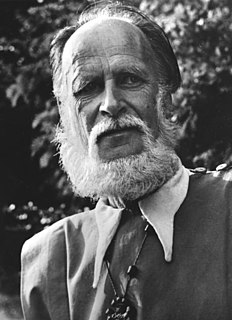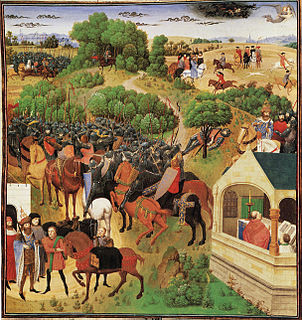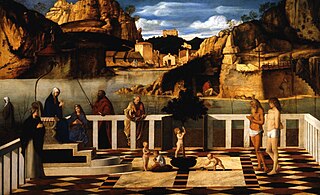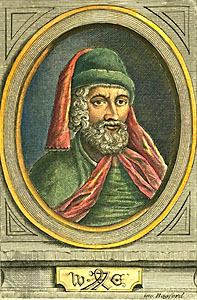
Philippa of Hainault was Queen of England as the wife of King Edward III. Edward promised in 1326 to marry her within the following two years. She was married to Edward, first by proxy, when Edward dispatched the Bishop of Coventry "to marry her in his name" in Valenciennes in October 1327. The marriage was celebrated formally in York Minster on 24 January 1328, some months after Edward's accession to the throne of England. In August 1328, he also fixed his wife's dower.

Lanza del Vasto was an Italian philosopher, poet, artist, Catholic and nonviolent activist.

The chanson de geste is a medieval narrative, a type of epic poem that appears at the dawn of French literature. The earliest known poems of this genre date from the late eleventh and early twelfth centuries, before the emergence of the lyric poetry of the trouvères (troubadours) and the earliest verse romances. They reached their apogee in the period 1150–1250.

Ship of Fools is a painting by Hieronymus Bosch, now on display in the Musée du Louvre, Paris. The surviving painting is a fragment of a triptych that was cut into several parts. The Ship of Fools was painted on one of the wings of the altarpiece, and is about two thirds of its original length. The bottom third of the panel belongs to Yale University Art Gallery and is exhibited under the title Allegory of Gluttony. The wing on the other side, which has more or less retained its full length, is the Death and the Miser, now in the National Gallery of Art, Washington, D.C.. The two panels together would have represented the two extremes of prodigality and miserliness, condemning and caricaturing both. The Wayfarer was painted on the right panel rear of the triptych. The central panel, if existed, is unknown.
Anglo-Norman literature is literature composed in the Anglo-Norman language developed during the period 1066–1204 when the Duchy of Normandy and England were united in the Anglo-Norman realm.
Années de pèlerinage is a set of three suites for solo piano by Franz Liszt. Much of it derives from his earlier work, Album d'un voyageur, his first major published piano cycle, which was composed between 1835 and 1838 and published in 1842. Années de pèlerinage is widely considered as the masterwork and summation of Liszt's musical style. The third volume is notable as an example of his later style. Composed well after the first two volumes, it displays less virtuosity and more harmonic experimentation.
Jean de Meun was a French author best known for his continuation of the Roman de la Rose.

St Patrick's Purgatory is an ancient pilgrimage site on Station Island in Lough Derg, County Donegal, Ireland. According to legend, the site dates from the fifth century, when Christ showed Saint Patrick a cave, sometimes referred to as a pit or a well, on Station Island that was an entrance to Purgatory. Its importance in medieval times is clear from the fact that it is mentioned in texts from as early as 1185 and shown on maps from all over Europe as early as the fifteenth century. It is the only Irish site designated on Martin Behaim's world map of 1492.
L'Histoire de Guillaume le Maréchal is the verse biography of William Marshal, 1st Earl of Pembroke, written shortly after his death at the request of his son, William Marshal, 2nd Earl of Pembroke. The biography is composed of 19,214 lines, in rhyming octosyllabic couplets, and was written in the Anglo-Norman language. It is the major extant text documenting Marshal's life. It was written based on the surviving account of his squire John D'Erlay. It can be used to provide insight into the two English kings, Richard I and his successor John, both of whom William served. The single surviving manuscript of the work, dating perhaps from the second quarter of the thirteenth century, was once in the collection of Sir Thomas Phillipps, and is now housed at the Pierpont Morgan Library in New York City, under the catalog number M888.

Après une lecture du Dante: Fantasia quasi Sonata is a piano sonata in one movement, completed by Hungarian composer Franz Liszt in 1849. It was first published in 1856 as part of the second volume of his Années de pèlerinage. This work of program music was inspired by the reading of Dante Alighieri's most famous epic poem, the Divine Comedy.
Le Pèlerinage de Charlemagne or Voyage de Charlemagne à Jérusalem et à Constantinople is an Old French chanson de geste dealing with a fictional expedition by Charlemagne and his knights. The oldest known written version was probably composed around 1140. Two 15th-century reworkings of the story are also known.
Henri Daniel-Rops was a French Roman Catholic writer and historian whose real name was Henri Petiot.

Le pèlerinage de Lourdes is the only encyclical of Pope Pius XII issued in French. It includes warnings against materialism on the centenary of the apparitions at Lourdes. It was given at Rome, from St. Peter's Basilica, on the feast of the Visitation of the Most Holy Virgin, July 2, 1957, the nineteenth year of his pontificate.
Jean-Claude Flornoy was a French specialist of the Tarot of Marseille, a writer and card maker working on bringing back to life historical Tarot decks. He especially worked on restoring the Jean Noblet and Jean Dodal decks.
The Karlamagnús saga, Karlamagnussaga or Karlamagnus-saga was a late-thirteenth-century Norse prose compilation and adaptation, made for Haakon V of Norway, of the Old French chansons de geste of the Matter of France dealing with Charlemagne and his paladins. In some cases, the Karlamagnús saga remains the only source for otherwise-lost Old French epics.
Guillaume Alexis was a French Benedictine monk and poet of the late 15th and early 16th centuries, nicknamed the "Good Monk". His abbey was that at Lire, in the diocese of Évreux, He became prior of Bussy, in Perche. In 1486 he went on a pilgrimage to Jerusalem and died there, a victim of Ottoman persecution.

The Holy Allegory is a painting by the Italian Renaissance master Giovanni Bellini, dating from c. 1490 to 1500. It is in the Uffizi gallery in Florence, Italy.

The Chartres pilgrimage, also known in French as the pèlerinage de Chrétienté, is an annual pilgrimage from Notre-Dame de Paris to Notre-Dame de Chartres occurring around the Christian feast of Pentecost, organized by Notre-Dame de Chrétienté, a Catholic lay non-profit organization based in Versailles, France. Although the pilgrimage has existed since 1983, the organisation was not founded until 2000.










